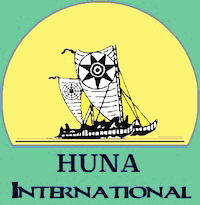Huna Article
Huna International
About Creating Anahola
by Serge Kahili King
This article is based on the Foreward from the book Creating Anahola: Huna Perspectives on a Sacred
Landscape by a friend formerly known as Curby Rule. The book may or may not still be available, so I
am only commenting on parts of it.
Curby's book is based on a marvelous concept: that we all have an intimate relationship of mutual influence
with our environment that goes far beyond the limits of ordinary physics and psychology. At the same time,
it is based on Curby's deep love of Hawaii and an unusually perceptive understanding of Hawaiian culture.
Without hesitation the book starts right off by plunging into one of the aspects of Hawaiian culture that is
difficult for most non-Hawaiians to understand. Actually, it is difficult for most Hawaiians to understand.
This is the fact that Hawaiian do not now have, and never have had, a homogenous culture.
The people whom we call Hawaiians came to these islands from many different places, at many different times,
with many different ideas, beliefs, religions, legends, and customs. Their language was similar and they
shared many cultural concepts and practices, but their differences were as striking as their similarities.
For an example, let's take a brief look at the tradition of Hawaiian dance, which has been called
hula only since the 1800s.
According to some Hawaiian families, hula was taught to people by the gods, but according to other families
it was a human who invented it and taught it to the gods. One tradition says it was the forest goddess Laka
who inspired it; another says it was the wind god Laka who did that; and another claims that a brother and
sister, both named Laka, brought hula to the islands from Tahiti. Some families declare that in ancient
times only men danced the hula, while other families hold that the original dancers were women. And yet none
of this prevents Hawaiians of different family beliefs from dancing together.
One other example would be in the area of language. As Curby notes, some Hawaiians today are very insistent
that their way of pronouncing the language is the only correct way. However, the writings of the early
missionaries describe quite another problem. One of the most frustrating things they encountered while
trying to turn Hawaiian into a written language was the fact that the Hawaiians themselves had so many
different ways of pronouncing it. And if that were not bad enough, the Hawaiians didn't seem to care or
notice. On one occasion a missionary asked an educated Hawaiian the proper way to pronounce a certain word.
"Is it a'ale or a'ole?" the missionary asked. "That's correct," said the Hawaiian.
The Hawaiians of old did not have any religious wars that we know of, nor did they seem to give any
importance to racial distinctions. Curby has tapped into this peculiarly Hawaiian attribute of tolerating
differences in his way of drawing from multiple sources of Hawaiian and non-Hawaiian knowledge to bring them
together in an emotionally coherent whole.
As a people, the ancient Hawaiians were both poetic and practical at the same time. They never indulged in
knowledge for its own sake, however beautifully they might present it. Knowledge always had to be practical
as well as interesting. Many of the great legends, such as the tales of Pele the Volcano Goddess, were at
the same time verbal maps giving instructions on how to get from one place to another.
One day, years ago, Curby and I hiked together on an inland trail from Princeville Ranch on the North Shore
of Kauai to the Keahua Forest near the foot of Mt. Wai'ale'ale. Along the way we noted an unusual rock
formation across a valley and we speculated on the possibility of exploring it one day. That experience with
Curby inspired me to eventually enter the wilderness and make the attempt to find out what those rocks
really were. Although I never did reach them, the journey itself changed my life in profound ways (to see
that story click here). If you ever get the
opportunity, I believe that experiencing this book will help you embark on life-changing journeys as well.
Copyright Huna International 2005

|

